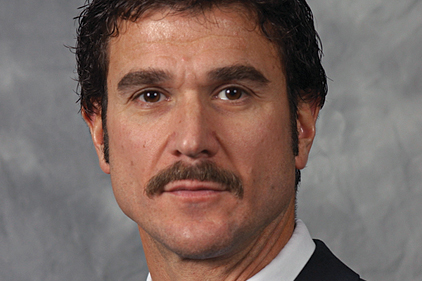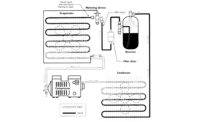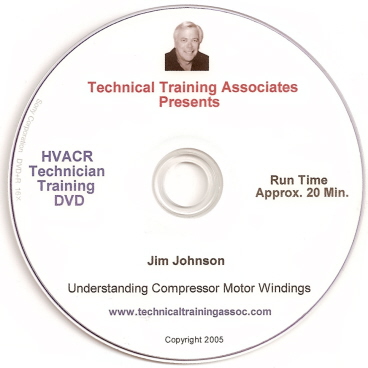My column in the Jan. 14 issue of The NEWS dealt with causes for compressor overheating and high compressor-discharge temperatures. Compressor overheating is often referred to as the HVACR industry’s most serious field problem. Causes for compressor overheating were listed into four main categories, and then broken down into their causes. The four main categories were high condensing pressures, low suction pressures, high compression ratios, and high compressor (total) superheat.
Causes for high condensing pressures can include dirty condenser coils, burned out condenser fan motor, broken condenser fan belts, undersized condenser coils, overcharge of refrigerant, non-condensables in the system, high ambient temperature, re-circulated air over the condenser, and mixed or wrong refrigerant.
 Causes for low suction pressure could be TXV or capillary tubes underfeeding, low evaporator heat loads, end of the cycle, temperature set point set too low, frosted evaporator coils, defrost clock motor burned out, defrost heater burned out causing iced coils, inappropriate defrost schedules, evaporator fan motor out, kinked suction lines, dirty or plugged suction line filter, dirty or plugged liquid line filter/drier, kinked liquid lines, and/or plugged compressor inlet screens.
Causes for low suction pressure could be TXV or capillary tubes underfeeding, low evaporator heat loads, end of the cycle, temperature set point set too low, frosted evaporator coils, defrost clock motor burned out, defrost heater burned out causing iced coils, inappropriate defrost schedules, evaporator fan motor out, kinked suction lines, dirty or plugged suction line filter, dirty or plugged liquid line filter/drier, kinked liquid lines, and/or plugged compressor inlet screens.
Causes for high compression ratios could include low suction pressures, high head pressures, or a combination of both. The higher the compression ratio, the higher the compressor’s discharge temperature will be. This happens because more heat of compression will be generated when compressing the gases through a greater pressure range.
Causes for high compressor superheats could be starved evaporator, restricted liquid line, undercharge, plugged filter drier, kinked liquid line, TXV, or capillary-tube underfeeding.
It was also mentioned that the limit to any compressor discharge temperature is 225˚F. If the discharge temperature gets higher than 225˚, the system may start to fail from worn rings, acid formations, and oil breakdown. Remember, if the discharge temperature is 225˚, the back of the actual discharge valve will be about 75˚ hotter. This will bring the actual compressor’s discharge valve to 300˚. It is a known fact that most oil may start to break down and vaporize at 350˚.
If this occurs, serious overheating problems will occur. And, since compressor overheating problems are today’s most serious causes for compressor overheating, service technicians must always monitor compressor discharge temperatures and keep them under 225˚. Some manufacturers may mention higher compressor discharge temperature limits. However, a good conservative number is 225˚.
Oil Decomposition and Loss of Lubrication
High compressor-discharge temperatures can cause the compressor’s oil to decompose, causing a loss of lubrication to the compressor’s moving parts. In the last 20 years, technology has enabled chemical engineers to highly refine oils in order to raise the temperature in which they will decompose. However, they are still vulnerable to losing their lubrication films needed for proper compressor lubrication at these higher temperatures before decomposition begins. Mineral oils lose the film somewhere between 305˚ and 330˚.
Decomposition of mineral oil will start to occur at approximately 350˚, with Polyol Ester (POE) lubricants at about 400˚. When these lubricants break down at these elevated temperatures, they start to polymerize. Polymerizing is nothing more than the different molecules of the oil starting to combine and forming larger molecules. The oil first appears dark and thick, then very sludgy, and finally forms a fine solid powder.
Acids and Sludge

|
| Figure 1. Back of compressor discharge valve. (Photo courtesy of Ferris State University.) |
Heat is a catalyst in a complex chemical reaction that will cause refrigerants (CFCs, HCFCs, and HFCs) and moisture to form acids and more moisture. Once acids form, metal corrosion can occur. When acid travels through the refrigeration system and mixes with the system’s oil, globules of sludge will form, along with organic acids and oil decomposition products. Sludge is a tightly bound mixture of water, acid, and oil. Sludge can exist as minute, slimy, or sticky solids, powdery solids, or thick, slimy, and oily liquids.
So, it might be said that:
Moisture + Acid + Oil = Sludge
Sludge breaks down the oil and reduces its lubricating ability which will cause serious mechanical damage to the system. Often, small particles from the corroded parts can be carried in the sludge. These sludges and solids tend to build up in the hottest points in the system, which are the discharge-valve seats (Figure 1). The valves will no longer seat properly and wiredrawing occurs, which is when vapor is forced through a very small orifice at high speeds, creating friction and elevating temperatures above 1,000˚.
So, for good compressor health and lubrication, keep those compressor discharge temperatures down below 225˚.
Publication date: 2/11/2013










